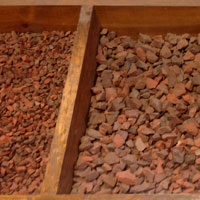Phil Bazan – Adel’s United Brick and Tile Company

This month we toured the United Brick and Tile company, a division of Sioux City Brick. Plant Manager Phil Bazan shared with us the history and artistry of brick making in Adel.

Phil Bazan – Adel’s United Brick and Tile Company
For more than 100 years Adel, Iowa has been well known for its brick.
From stately homes to historic streets, brick is what put Adel on the map.
Dallas County is home to high quality red and blue clay, the key ingredients to brick making.
This was true when R.M. Kearns & Company established a brick plant south of Oakdale Cemetery on Butler Creek in 1880. At that time, the plant employed 25 men and turned out 20,000 bricks daily.

Adel Plant – 1910
Now, the Adel plant employs 100 employees and produces approximately 92 million bricks per year. At the turn of the century, a new plant was built near the railroad tracks on the southwest edge of town where the plant continues to reside today.

The Adel Plant Today
Adel bricks are known for their consistency in color, size, and quality. During its prosperous beginnings, this was thanks to the innovation and imagination of owner Halvor Rufus (H. R.) Straight who filed 87 patents for brick making equipment and brick and tile design during his lineage. With the aid of good advertising, the Adel plant remained busy when many brick companies suffered for business. The plant was continually modernized and many of H.R. Straight’s patents of labor saving machinery were put to work which helped the Adel brick plant stand above the rest.
In 1926, a merger of red brick plants took place consolidating 32 plants in four states into a new company called United Clay Products Company. H. R. Straight sold the Adel plant to the new company for a profit as it was considered to be the most efficient plant in the group. In 1958 Sioux City Brick purchased the Adel plant, creating the United Brick and Tile division.

Sioux City Brick is known for building the first tunnel kiln in Iowa, which greatly increased production. Tunnel kilns, long brick hallways that heat to more than 2000 degrees, produced brick more economically; quality control improved, as did color consistency. This allowed for greater distribution throughout the country.
Phil Bazan joined Adel’s United Brick and Tile in 1995. Phil graduated from Iowa State University’s Ceramic Engineering program and his passion for bricks is infectious. During the tour, Phil shared the step-by-step process of mining the clay, creating the perfect ratio of red to blue clay, forming and baking the bricks, inspecting the bricks, packaging, and shipping. It is clear that while the processes have been modernized, the human component is a crucial component for success.
“There is a discussion within the industry ‘[is brick making] more science or art?’ Its a lot more science than it used to be, but brick making is still very much an art.”
The process begins in the ground. Each summer, clay is mined during a short 6-12 week period and stockpiled for use throughout the year. Red clay alone is too sticky to build bricks; blue clay, or shale, is too sandy. The ideal balance is created each year based on the stockpile’s properties.
“The characteristics of the stockpile change each year. When [the clay] fires we want it to be the same color, the same shrinkage, and the same absorption. It’s really the clay that everything is based on. We spend a lot of time testing the new stockpiles, and testing the temperatures of the dryer and kiln. The firing recipe for each batch of bricks is saved so we can closely match the bricks you bought 5 years ago.”
Approximately 6 tons of clay is used daily; crushed and sifted through screen to make a coarse powder.
 “The powder is then conveyed to the Water Closet which is filled with several shower nozzles. The clay drops down and we spray the clay while its in the air. You don’t want to add water to the top of the clay because it doesn’t mix well.
“The powder is then conveyed to the Water Closet which is filled with several shower nozzles. The clay drops down and we spray the clay while its in the air. You don’t want to add water to the top of the clay because it doesn’t mix well.
The clay falls into a bin with turning knives that mix the clay and water together to temper the clay’s consistency. The clay will then drop into a vacuum chamber to remove the air from the clay so we get a really firm extrusion that won’t pull apart. “
Moving down the line, the clay is forced through a machine, simultaneously smoothing the clay, creating evenly spaced core holes, and if desired, can be altered with any number of colors or coatings. Scraps are fed back into productions so that nothing is wasted.
The clay is then lifted through metal wires that slice the column into individual bricks. From here, the blocks move to the Facer, which dusts them with silica sand to prevent the bricks from sticking to one another, and stacks the clay onto rolling cars for firing. One car holds 4500-10,500 bricks depending on residential or commercial sizing.

“The Adel location is a 5-Day operation with 7 days of production. We don’t shut down the kiln and dryer because it takes several days to cool down and restart. As a result, we have a holding room that is warm and humid that keeps the clay stable for firing later. We make somewhere around 250,000 bricks a day, or about 10 houses a day.”
The cars then move into the Holding Room or the Dryer depending on need. The Dryer starts at 120 degrees. By the time the brick has moved to the end of the dryer, the temperature has reached 450 degrees. The Dryer slowly extracts the moisture so that the bricks do not explode while baking. Bricks then roll down the line to the kiln.
The Kiln starts at 400-600 degrees and will be ramped up to 1900-2040 degrees depending on the project.
During the baking process, gases are sometimes fed into the chamber to promote oxidation, a chemical reaction that changes the color of the bricks.
 Once the bricks are cooled, employees dust off the silica sand and check for chipping. Any bricks that are damaged during the baking processes are crushed and recycled as Brick Chips.
Once the bricks are cooled, employees dust off the silica sand and check for chipping. Any bricks that are damaged during the baking processes are crushed and recycled as Brick Chips.
Brick Chips are available in a variety of consistencies and serve many purposes. The mulch is long lasting and colorfast, creates an appealing contrast to flowers, shrubs, and sidewalks, resistant to harboring insects, and heavy enough to withstand leaf blowing in the fall. Brick Chips are an attractive mix of red and brown colors making them perfect for residential, commercial, and sports related needs. Brick Chips are sold locally at the Adel plant.
From here, the bricks are blended and packaged for shipping around the country. Blending the bricks is important, as each car and each brick, is slightly different from one another. Blending helps to create the iconic mosaic-feel expected of a brick structure.
Adel bricks are shipped internationally and used to create banks, schools, shopping malls, houses, and more. Locally, Adel bricks are proud to circle the downtown square and spread throughout historic neighborhoods. Speaking to their strength and durability, most of the original brick used to pave the streets were salvaged and reused during Adel’s historic street renovation.
Phil and the team are proud to be part of Adel’s long tradition with brick. If you would like to incorporate these locally sourced and produced Adel bricks in your next home or office project, visit www.siouxcitybrick.com to find a showroom near you.
“Made in America- owned by Americans. There is still a place where integrity, craftsmanship, and quality intersect. That place is Sioux City Brick. We make great brick.” 100 Year Anniversary, Sioux City Brick, 2013
United Brick and Tile
Division of Sioux City Brick
Phil Bazan, Plant Manager
1831 Main Street | Adel, IA 50003
Phone: (515) 993-4549
Website: www.siouxcitybrick.com
Originally Published Dec 1, 2016






